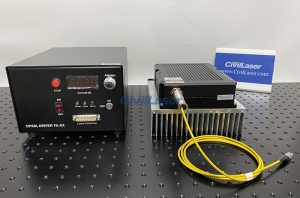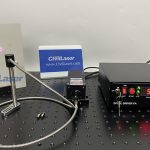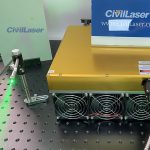Most powerful blue laser pointer 445nm 3000mw laser — 2×16340 or 2×18650
Most powerful blue laser pointer 445nm 3000mw laser — 2×16340 or 2×18650
1. Battery installation method.
.jpg)
Never install 3 batteries; it will burn out the laser as quick as a flash.
.jpg)
If you brought this blue laser pointer from our web store, please according to the following standards, strictly regulate the use of:
The International Electrotechnical Commission (IEC): the establishment and management of international laser safety standards, IEC 60825-2007
American: America National Standards Association (ANSI) laser safety committee Z136-2000 standard
China:
A) Radiation safety of laser products: GB7247.1-2001
B) Safety standards of laser protection device: GB18151-2000
C) Laser safety standards: GB18217-2000
D) Safety standards of laser operation field: GB10435-1989
According to the classification of laser products (GB 7247.1-2001) standard, this product belongs to the class IV: even by the laser diffuse reflection also is likely to cause harm, will burn the skin, ignite flammable materials, you should be particularly careful when the user operates this kind of laser source.
The wavelength of this product is the 445NM, visible light (400nm-700nm) laser, and the impact on the eye mainly for the photochemical and thermal effects induced retinal injury, The main effects on the skin mainly as dark , light-sensitive effect, skin burns .
Continuous density laser irradiation eyes will cause irreversible damage, please exercise caution when in close use, and please wear protective goggles for protection.
When not in use, should be placed in the minors cannot get place, and remove the batteries, turn off the switch, twist out safety pin for safekeeping, to prevent accidental injury events.
Our purchasers to determine before buying, we have notification obligation, the buyer must be observed, if the buyer does not listen to advice all the consequences of what happened, borne by the buyer, the shop is not responsible.
In addition, the restaurant lasers prohibit the sale to minors, please note!
Blue 3W laser pointer Precautions
The blue 3W upgrade project description:
1. After the upgrade, the attack of head is the 316 stainless steel material, high hardness, sufficient for self-defence and emergency hit hard materials like glass or material under normal circumstances.
2. The laser module heat radiating area increased one-third compared with the blue 2W, the better ability of continuous working.
3. Added safety latch and switch contacts, safety pin made from the plastic material to copper nickel-plated contacts plus higher conductive properties of 24K gold.
4. Added the ignition position line, to help with quick guide to had not been exposed to laser products buyers.
Have to take practical action to optimize the product, so that customers buy products with more practical value in use and continuous improvement, we will continue to move forward, and strive to bring you better products, never negative the laser lover’s love.
The blue 3W instructions:
1: using a laser lamp, without prolonged tube with two short battery, positive towards the tail cover, short battery and long battery cannot mix, also cannot be loaded at the same time 4 short batteries, battery single voltage is 3.7V, the flashlight for 7.4V driver.
Add the extension tube to put two long battery, positive towards the tail cover, cannot hold two small batteries a large battery.
Note: If fault wrong battery lead, is not in the scope of free warranty.
2: the laser diode is a high fever components, overheating could cause the laser diode accelerated aging, affect the service life of the laser pointer, so we suggest that when the heating is better in your hand, close it and cooling it.
3: multi gear products with exclusive four grade, dimming mode, divided into strong, weak and slow, flash mode, all the stalls are with slow start protection, light way: open the flashlight quickly after pressing the switch two times, into the next gear, laser flashlight with memory model, closed hand electric five seconds later, open default reply to open before the stall next time.
4: the use of LED lighting lamp holder, an 18650 battery driver, LED lamp is negative, so the battery negative pole with laser instead, with the correct method is positive in spring, negative towards the tail cover.
LED flashlight, with strong, weak, in the flash, SOS five stalls, continuous press two can enter the next gear.
5: Prohibited dismantle laser pointer, otherwise there may void the warranty.
6: the prohibition by the human body, especially the eyes, any accidents such as buyers do not follow the instructions as a result, the shop will not bear any responsibility.
Most Powerful burning Green Laser pointer Instructions – 1 x 18650 battery
Most Powerful burning Green Laser pointer Instructions – 1 x 18650 battery
1. Battery installation method.

The anode point to the lid.
.jpg)
1 x 18650 battery (Not Include)
2. The use of attention
Do not continuous light the laser over 120 seconds, we advice you turn off the laser every 60 seconds when the room temperature is too high. This is a high power handheld laser pointer, large heat productivity but do not have the heat radiating device, long time lighting is easily burnt out laser tube, will cause the laser point does not light or faint light.
3. Security warning
★ Do not look at the laser directly.
★ Do not use laser irradiation of others.
★ Do not use laser irradiation the objects which is easy to reflect light.
★ Do not let a minor child touch laser pointer.
Charge Description:
When charging the red light is on, after charging full the signal light is green.
Charging time reference:
1. 18650 battery: About 6 hours;
Lithium battery using common knowledge:
1. Do not over charging, over discharge, or whatever the lithium battery once will be scrapped (remember not to reduce the service life, was scrapped)
2. Do not run out the battery power, when you find that the lights dimmed you need to charge. (Do not charge too long time, just full is the best 😉
3. Beware of the battery is shorted, because the battery is not set short-circuit protection can result in excessive heat, or explosion
4. Do not throw batteries into fire, otherwise it will explode.
日本語 使用注意
連続使用時間は120秒を超えないでください。室外の温度は高い時に60秒毎に閉じたほうがいいです。
これはレーザーポインターの高効率のハンディタイプです。高効率なので発熱が大きい、それにハンディタイプは放熱装置が配置されていないので、長時間使用とレーザーパイプが燃しやすい、レーザーポインターが点滅しないや光が微弱の問題が起こります。
安全警告
★ レザーを直視ないでください。
★ 他人にレザー照射をしないでください。
★ 反射し易いものにレザー照射をしないでください。
★ 未成年の子供をレーザーポインターに接触させないでください。
Powerful blue laser pointer Manual – 2 x 16340 batteries
Powerful blue laser pointer Manual – 2 x 16340 batteries
1. Battery installation method.

The anode point to the lid.
.jpg)
2 x 16340 battery (Not Include)
2. The use of attention
Do not continuous light the laser over 120 seconds, we advice you turn off the laser every 60 seconds when the room temperature is too high. This is a high power handheld laser pointer, large heat productivity but do not have the heat radiating device, long time lighting is easily burnt out laser tube, will cause the laser point does not light or faint light.
3. Security warning
★ Do not look at the laser directly.
★ Do not use laser irradiation of others.
★ Do not use laser irradiation the objects which is easy to reflect light.
★ Do not let a minor child touch laser pointer.
Charge Description:
When charging the red light is on, after charging full the signal light is green.
Charging time reference:
16340 battery: About 4 hours;
Lithium battery using common knowledge:
1. Do not over charging, over discharge, or whatever the lithium battery once will be scrapped (remember not to reduce the service life, was scrapped)
2. Do not run out the battery power, when you find that the lights dimmed you need to charge. (Do not charge too long time, just full is the best )
3. Beware of the battery is shorted, because the battery is not set short-circuit protection can result in excessive heat, or explosion
4. Do not throw batteries into fire, otherwise it will explode.
日本語 使用注意
連続使用時間は120秒を超えないでください。室外の温度は高い時に60秒毎に閉じたほうがいいです。
これはレーザーポインターの高効率のハンディタイプです。高効率なので発熱が大きい、それにハンディタイプは放熱装置が配置されていないので、長時間使用とレーザーパイプが燃しやすい、レーザーポインターが点滅しないや光が微弱の問題が起こります。
安全警告
★ レザーを直視ないでください。
★ 他人にレザー照射をしないでください。
★ 反射し易いものにレザー照射をしないでください。
★ 未成年の子供をレーザーポインターに接触させないでください。
Instructions Small Laser Module With TTL — CivilLaser
Small Laser Module With TTL — CivilLaser
TTL laser module Operating Instructions
——————————————————————————————————————-
Jun 23,2015 Update
TTL laser modules inlcude three lines.
1. Red Line: Red line connect the positive;
2. Black Line: Black line connect the negative;
3. Yellow Line: Yellow line connect the positive signal line, Negative signal line connect the black line;
Continuous work-mode (1mw~10mw Laser module)
1. Red line connect the positive power supply;
2. Black line connect the negative power supply;
3. Yellow line vacancy;
Continuous work-mode (10mw~100mw Laser module)
1. Red line and Yellow line connect the positive power supply;
2. Black line connect the negative power supply;
TTL modulation(1kHZ~1000kHZ / 2V-5V)
1. Red line connect the positive power supply;
2. Black line connect the negative power supply;
3. Yellow line connect the positive signal line;
4. Black line connect the negative signal line;
(Note: In Modulation mode, the black line be connected the negative power supply and the negative signal line;)
——————————————————————————————————————-
Modulation module instructions
1. When in use, connect the red and yellow line, the module will be bright, and in continuous work mode;
2. When you want modulation, connect the negative of signal line to black line, and positive to yellow line, keep the red line suspended, then the module in modulation mode;
3. Signal input should be in the range of 300KHZ;
4. The input voltage of modulation work is 3.3V, continuous work input voltage is 3.3V.

.jpg)

Laser knowledge summary (Updating…)
Summary of Common Laser Knowledge (to be continuously updated)
☆Laser module — The relationship between the power,brightness and working disance
http://www.blog.civillaser.com/?p=70
☆Introduction to the characteristics of laser pointers of various wavelengths (colors)
http://www.blog.civillaser.com/?p=146
☆Which color laser beam brightest?
http://www.blog.civillaser.com/?p=33
☆Different laser wavelengths which band burning something stronger?
http://www.blog.civillaser.com/?p=37
☆Focus adjustable burning laser poitnre
http://www.blog.civillaser.com/?p=161
☆Laser beam class level & Laser Safety Classification
http://www.blog.civillaser.com/?p=58
☆Various wavelengths of the laser beam/ Laser Knowledge — CivilLaser
http://www.blog.civillaser.com/?p=77
☆Comparison of brightness of light spot and beam among lasers of different wavelengths
http://www.blog.civillaser.com/?p=159
☆Instructions Small Laser Module With TTL — CivilLaser
http://www.blog.civillaser.com/?p=120
☆Most powerful blue laser pointer 445nm 3000mw laser — 2×16340 or 2×18650
http://www.blog.civillaser.com/?p=131
☆ Most Powerful burning Green Laser pointer Instructions – 1 x 18650 battery
http://www.blog.civillaser.com/?p=128
☆ Powerful blue laser pointer Manual – 2 x 16340 batteries
http://www.blog.civillaser.com/?p=124
☆Different wavelength has different light emitting principle.
http://www.blog.civillaser.com/?p=35
☆Different laser wavelengths, What are the shape of the laser spot?
http://www.blog.civillaser.com/?p=39
☆CivilLaser DPSS Lasers 405nm 457nm 473nm 515nm 520nm 532nm 561nm 589nm 607nm 637nm 671nm
http://www.blog.civillaser.com/?p=141
☆Calculation method of laser divergence angle
http://www.blog.civillaser.com/?p=151
☆Laser Spatial mode
http://www.blog.civillaser.com/?p=155
☆Bonding crystal, optical cement crystal, separated crystal
http://www.blog.civillaser.com/?p=157
Get laser giveaway from Civil Laser
Laser Pointer / Laser sight: www.lucklaser.com
Laser Module / Laser diode / DPSS Laser / : www.civillaser.com
If you are interested in our products and want to be our distributor, tell us your company information, some kind of laser products we can support free samples to our customers.
Laser module / Laser marking device / Laser Module Knowledge — CivilLaser
Laser module / Laser marking device / Laser Module Knowledge — CivilLaser
Laser shape: Dot / Line / Crosshair
The more power greater more brightness.
When in use, not power greater the better, depending on the work environment needs!
① high-power, high brightness, can work in bright light, but poor accuracy!
② Small power brightness is small, but high accuracy!
1. The laser beam will absolutely not allow exposure to human and animal eyes.
2. Red laser module, blue violet laser module with the power 10MW-150MW can continuous working time is 24hours (size more than 16*68mm), more than 200MW power is not recommended more than 30 minutes, otherwise it will overheat and effect of LD life.

Various wavelengths of the laser beam/ Laser Knowledge — CivilLaser
Various wavelengths of the laser beam/ Laser Knowledge — CivilLaser
1. Brightness: Green laser beam > Red laser beam > Blue-violet laser beam
2. Price: Blue-violet laser beam > Green laser > Red laser
3. Poly thermal performance (Burning feature): Blue-violet laser = Red laser > Green laser
4. Stability: Red laser = Blue-violet light > Green laser(green light influenced by the climate, cold environment to make
With, you need to warm up)













.jpg)
.jpg)
.jpg)
.jpg)
.jpg)
.jpg)
.jpg)
.jpg)
.jpg)
.jpg)
.jpg)
.jpg)
.jpg)
.jpg)






